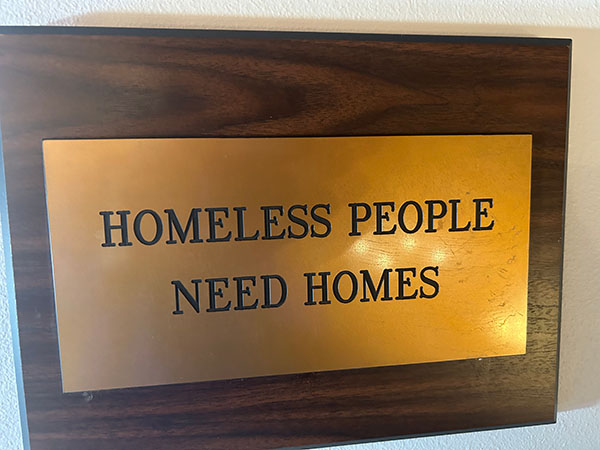Just about a year ago, data collection was completed by the University of California-San Francisco (UCSF) on one of the largest studies conducted on homelessness in decades.
The findings, released this year, are important for public policy on health, housing, and homelessness.
But arguably the most striking feature of those results, although they came from well-designed research, are not specific to this study.
Rather, what is most remarkable is how very similar the current results are to findings from 40 years ago.
More specifically, the results once again show that homeless people are an especially vulnerable population with multiple serious health and human service needs—who are receiving little assistance.
It’s important to look at those findings a little more closely, given Homelessness Awareness Month, given the Longest Night Memorial, (which remembers the large number of people who die homeless each year in America), and given the ongoing crisis of homelessness,
Current Findings
The current UCSF study results, which used data from a representative sample of over 3100 homeless people, found that homeless people experienced:
- High rates of trauma, including sexual and physical abuse. These experiences often preceded homelessness but individuals often went through these kinds of traumas and abuses again while homeless.
- High rates of mental health symptoms. Many also had histories of mental health hospitalizations and the majority of these hospitalizations preceded homelessness. Further, relatively few were currently receiving any mental health services.
- A majority also had substance use problems with alcohol, drugs, or both. Again, few were receiving any current treatment or services.
- Many also had physical health problems.
- Individuals on average had very low incomes.
- Minorities were overrepresented among homeless people.
- Although most wanted help, few were receiving any assistance, including for housing.

Photo by Jon Tyson on Unsplash
- Many experienced long or repeated episodes of homelessness.
- Contrary to stereotypes, the vast majority were long-term residents of the area or state.
Forty Years Ago
The current findings about the needs and experiences of homeless people are remarkably similar to the results a colleague and I found in the early 1980s, in one of the first representative, scientific studies of homeless people.
In particular, we found:
- A large number of homeless people suffered from mental health symptoms. Many had also been hospitalized for these problems before ever becoming homeless, but few were being provided any treatment or service while homeless.
- Many people then had also experienced serious traumas, including physical and sexual abuse, both before and after becoming homeless.
- Substance abuse was also common, though very few were currently being provided any treatment.
- The vast majority were very low-income and few were receiving any employment or financial assistance.
- Racial minorities were also overrepresented then.
What’s changed?
A fair question is what has changed about homelessness in the past 40 years?
Clearly, the answer is not much, at least when it comes to the experiences, needs, and characteristic of homeless people,
There are a few differences, such as more people sleeping outside (on the streets, in tents, etc.) now than then. The rate of substance use is also higher now, and the use of some drugs—such as methamphetamines and opioids—are far higher now.

Photo by Jon Tyson on Unsplash
But these are more differences of degree than kind.
In sum, little has changed about homeless people over the past 40 years.
The lack of change is not an indictment of homeless people themselves, for by and large they represent a vulnerable, high-need group with multiple, unmet health and social needs.
But the ongoing presence of homeless people—especially those who suffer from traumas and serious mental health and health disorders—is a sad reflection on our public response to the needs of vulnerable and disabled citizens and to homelessness.
This is especially true because of what has changed substantially over the past 40 years:
We have much more science-based knowledge about how to end homelessness.
We Know How To End Homelessness
A number of services have been shown by scientific research studies to be effective (and cost-effective) for ending homelessness. As described in a prior post, these include:
- Housing initiatives, including Rapid Re-Housing (which provides short-term rental assistance to help people to quickly get back into housing and to prevent chronic homelessness) and the Housing First approach (which combines housing assistance with supportive services and rent financial management) to help people, especially those with mental illness and chronic homelessness histories, to get and stay stably housed.
- Assertive Community Treatment, an intensive community-based mental health service which my colleagues and I adapted for homeless people with serious mental illness
- The Community Reinforcement Approach for homeless people with alcohol and drug disorders.
These approaches are not always quick-fix solutions. But when combined with caring and persistent outreach and engagement approaches, they are effective for helping the vast majority of homeless people out of shelters and the streets and into stable, permanent housing.
Why Does Homelessness Continue?
If we have approaches to effectively end homelessness, why are there still so many homeless people, especially people with the same kind of characteristics and needs as 40 years ago? Indeed, if anything, the number of homeless people has grown again in recent years.
Three reasons are paramount.
1. Underlying causes continue unabated. Although we know how to help people leave homelessness and become stably housed, the underlying, structural causes of homelessness persist, propelling new people onto the streets and shelter.
The most powerful of these underlying causes is the lack of affordable housing. Housing costs continue to rise, crowding out thousands of people—especially those who are low-income with little financial wealth and few family supports—into homelessness. This is especially a critical factor in expensive cities.
The Los Angeles Times ran a series of informative articles about homelessness this year and found that Mississippi, one of the poorest states in this country, had a much lower per capita rate of homelessness than Los Angeles and California, in large part because of the availability of affordable housing there.

The lack of affordable housing is also the tip of the iceberg to an even larger structural societal problem—the growing disparities in income and wealth between the richest and the poorest Americans.
2. A shortage of needed services. Even as more Americans enter homelessness for the first time, it is also clear that homelessness continues because there is a woeful mismatch between the size of the current homeless population and the services and resources, such as mental health and housing programs, that are available to help them.
Simply put, though we have the know-how to end homelessness, the services and resources are simply not being provided in sufficient numbers to help all those who need assistance.
3. A failure of compassion and public priorities. In the deepest analysis, the continuing problem of homelessness in America can be laid at the feet of a failure of public policies. To date, we have simply not made ending homelessness a priority.
Unlike many other social and national problems, we know how to solve this issue.
But the failure to take the policy actions necessary to end homelessness—indeed, to fund them at only a fraction of what is necessary (and at a minute level of the funding for other policy initiatives, such as nuclear warheads)—represent a policy failure. It is arguable if this policy failure comes from a lack of public awareness, prejudices and stigma, or a lack of compassion—some have even argued America shows a more compassionate response to homeless animals than people. Most likely, it is a confluence of all of these and other factors.
What happens over the next 40 years?
As a new and young psychologist, I began to work with homeless people, hoping to be part of the larger growing health and housing movement in the 1980s that sought to end homelessness in America. It was a career path that I thought then would take five or ten years.
As time has shown, I was naïve then about the difficulty of the task.
However, I learned, both from research and clinical experience, that the greatest challenge was not in working with people who are homeless, even those experiencing serious mental health disorders, traumatic pasts, and substance abuse. That process takes effort, resources, and time—especially to build trust with people who have often been abused and suffered broken promises.
Rather, the greatest difficulty is the social-political one.
How do we change social policy to provide the necessary resources to help the hundreds of thousands of people out of homelessness and into stable housing?
And, just importantly, how do we change the underlying structural problems—especially of affordable housing and assistance for vulnerable people with disabilities—to close the floodgates into the streets and shelters?
To do so will take social and political action, especially to educate and to elect government officials who care enough to ensure that everyone, especially those with disabilities, can live in affordable housing, not on the streets.

Ultimately, this will involve social policy changes that we make not only for the poor, the disabled, the abused, and the homeless, but for all of us, as part of creating a more cost-effective and compassionate society.
For as Gandhi put it, the true measure of a society is how it treats its most vulnerable members.
If we provide the services that scientific research has shown are cost-effective, if we make affordable housing a reality, then we can end homelessness.
I can only hope then, though that point in time will be beyond my lifespan, that a study of homelessness will not even be necessary in another 40 years.
—
Lead photo by Mart Production on Pexels


Follow Me: